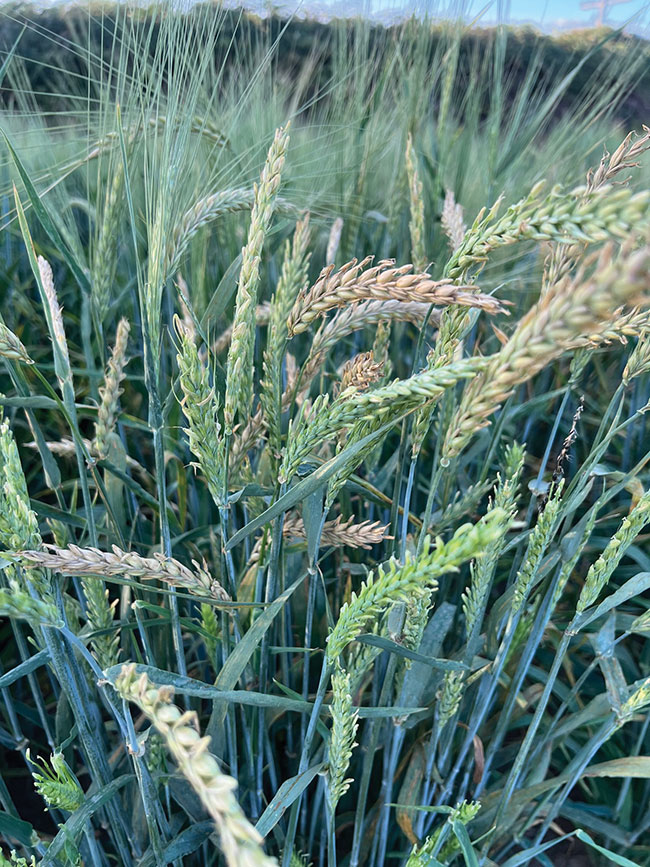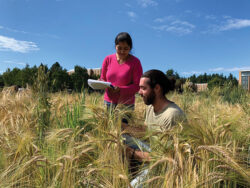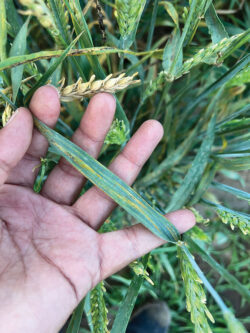
Features
Agronomy
Plant Breeding
A springboard for better barley
Developing a pre-breeding platform for western Canadian barley breeding.
September 20, 2023 By Carolyn King
 Brar’s barley pre-breeding work mainly targets genes for resistance to economically important barley diseases such as Fusarium head blight.
Photo courtesy of Gurcharn Singh Brar, University of British Columbia
Brar’s barley pre-breeding work mainly targets genes for resistance to economically important barley diseases such as Fusarium head blight.
Photo courtesy of Gurcharn Singh Brar, University of British Columbia If an important trait is not available in the Canadian germplasm pool for one of our crops, then researchers look for that trait in other sources, like varieties from other countries or wild relatives of the crop. However, pre-breeding – the work to find such a trait and move it into adapted lines that breeders can then use – is time-consuming and challenging.
Now, Gurcharn Singh Brar and his Cereal Breeding Lab at the University of British Columbia (UBC) are tackling barley pre-breeding.
“There are not a lot of cereal pre-breeding programs in Canada, especially for barley. So, when I started my program at UBC in 2020, I decided that our work on barley would be exclusively focused on pre-breeding, whereas in wheat we do pre-breeding and breeding,” says Brar, an assistant professor in plant science.
Along with desired traits such as resistance to a disease, crosses with wild relatives and landraces (local, traditional varieties) typically also bring in unwanted characteristics like lodging or late maturity. Brar says, “Pre-breeding essentially brings favourable alleles [gene variants] from other sources and increases diversity of the germplasm in any breeding program, but at the same time, cleaning up the garbage – the unfavourable side-effects, you could say – that come along with such crosses.”
His research group’s barley pre-breeding work mainly targets genes for resistance to economically important barley diseases such as Fusarium head blight (FHB), scald and net blotch, as well as bacterial leaf streak, an emerging Prairie disease and stripe rust, which is a concern in some regions of Western Canada.
“We cross Canadian barley with barleys from other countries, landraces, or wild barleys. Then we rate the material, for example, for resistance to multiple disease strains/races. And then we prepare some genetic stocks of pre-breeding germplasm, and those barleys can be used by breeders directly to make crosses with their elite barley varieties.”
Mining landraces for traits
Brar is leading a large collaborative project to delve into the traits available in the world-class barley landrace collection at Plant Gene Resources of Canada (PGRC) in Saskatoon.
PGRC, which is part of Agriculture and Agri-Food Canada (AAFC), is Canada’s gene bank for seed germplasm. Brar notes, “PGRC is best known for its barley collection, not only in Canada but worldwide. It has over 40,000 barley accessions [samples] in its collection.” This very diverse collection includes barley landraces from all over the world, as well as wild barleys.
“One research group in Germany characterized 22,000 barley landraces and other germplasm from a gene bank in ICARDA [International Center for Agricultural Research in the Dry Areas] and the IPK [Leibniz Institute of Plant Genetics and Crop Plant Research] gene bank. But when we looked into what they had characterized, we figured that there might be a lot of barley germplasm in PGRC that still remains uncharacterized,” he explains.
“We have this huge and great collection of barley here in Canada, so we thought why don’t we start looking into that collection and see if we could mine some good traits or some diversity?”
Brar and his group are working on this project with western Canadian barley breeders Aaron Beattie at the University of Saskatchewan and Ana Badea at AAFC-Brandon and barley disease researchers including James Tucker with AAFC-Brandon and Kelly Turkington with AAFC-Lacombe.
Brar explains that the first step in this project is to generate genotype data, or “DNA fingerprints,” for about 20,000 of the PGRC’s barley landraces. “Then, by the end of this year or early next year, we will shortlist about 2,000 to 3,000 spring barleys based on their DNA fingerprints. Next, we will do seed increase. And then we will start phenotyping them in the field; that is, we’ll grow them at multiple locations and assess their phenological characteristics/plant type and their reaction to different pathogens.”
This phenotyping work will be done jointly with their collaborators. “For example, Kelly Turkington at Lacombe will screen the barleys for scald, spot blotch and net blotch because these diseases are prevalent there and the climate there is suitable for these diseases,” notes Brar.
“Here in southern B.C., we have a very good climate for stripe rust, scald and Fusarium head blight, so we will be screening here for those diseases. And at Brandon, they have a very good environment for Fusarium, so James Tucker will screen the lines for Fusarium. So, we will all join forces and collect data on these barleys, which we will then share with each other.”
Once the phenotyping is completed for the 2,000 to 3,000 shortlisted lines, “we hope to identify tens or hundreds of good barleys that have a good plant type, good agronomic adaptation and good disease resistance,” he says.
These “good barleys” will feed into Brar’s pre-breeding program to help in improving elite Canadian barleys.

UBC Cereal Breeding Lab members rate disease response in the barley disease nursery.
Photo courtesy of Gurcharn Singh Brar, University of British Columbia
Tapping into wild barley traits
Another component of Brar’s barley research is to fully sequence the genome of a multi-disease resistant wild barley accession called Damon 11-11.
Brar is part of the International Wild Barley Sequencing Consortium, an international team that is sequencing the genomes of wild barley accessions. These accessions are Hordeum vulgare subspecies spontaneum, the progenitor of cultivated barley, which is Hordeum vulgare subspecies vulgare.
The consortium has a collection of about 300 diverse wild barleys,” notes Brar. “These wild ancestors have many good traits that we can harness, but they also have undesirable traits; for example, they can be very late maturing, very tall, very susceptible to lodging, and these types of things.”
The consortium’s work to sequence these wild barley genomes is important for increasing knowledge of the genetic diversity available in the wild barley germplasm pool and for analyses to develop molecular markers for key traits so breeders can screen their materials for the traits.
“These 300 wild barleys have been screened for multiple diseases and strains. Damon 11-11 is one of these 300 barleys. It is resistant to nearly all the diseases they have screened for. Some of these diseases are important to western Canada, such as scald, net blotch and spot blotch, as well as stripe rust, leaf rust, stem rust. That is why we decided to sequence Damon 11-11,” says Brar.
“Also, we have already started crossing Damon 11-11 with Canadian barleys so that we can bring in some of the good alleles from that wild barley into cultivated barley. But it will still be at least 10 to 15 years from now before we see varieties bearing some of those good traits from Damon 11-11.”
Disease screening support
Another way Brar’s group is helping Canadian barley breeding programs is through the disease nursery that his group has set up at UBC. This nursery screens barley for stripe rust and for FHB and DON (deoxynivalenol, a common FHB toxin that has implications for feed and food quality).
Along with screening Brar’s pre-breeding materials, the nursery also screens early and advanced breeding lines for breeders like Beattie and Badea.
Early detection of emerging strains
Another interesting project led by Brar involves early detection of new pathogen strains in wheat and barley; and assessing wheat and barley lines for resistance to these emerging strains. Both components of the project are key steps to help breeders develop new varieties that keep pace with continually changing disease strains.

Southern B.C. is a hotspot for stripe rust, so Brar screens his pre-breeding materials and lines from barley breeders for this disease in his disease nursery.
Photo courtesy of Gurcharn Singh Brar, University of British Columbia
The barley portion of this project focuses on net blotch, an important foliar disease. “To identify races of the net blotch pathogen, scientists usually use classical methods where they collect leaf samples, culture the pathogen in the lab and then make a single-spore culture,” says Brar. “They have a set of barley genotypes that they inoculate with the single-spore culture, and they determine the race of the pathogen based on the differing responses of the different genotypes. But that process takes more than a year.”
So, Brar’s program is aiming to use recently developed sequencing technologies to quickly determine net blotch races by sequencing certain genes in the pathogen.
He explains that the net blotch pathogen produces a few different types of compounds that are toxic to barley, with different pathogen lineages producing different toxins. “We already know which genes in the pathogen produce these toxins. So, if we sequence these genes using these rapid sequencing technologies, then we should be able to identify the lineage. That is our working hypothesis.”
Brar is working on this project with Xiben Wang at AAFC-Morden and other collaborators. The collaborators are sending net blotch samples from across western Canada to Brar’s group.
“Our objective is to bring leaf samples from the field, express their DNA or RNA, and then run it on the sequencer,” says Brar. “Then within a matter of weeks, we will be able to tell which race it is.”
Next, they will determine which net blotch races are the most prevalent. And then they will screen elite barleys, barley breeding lines and Brar’s shortlisted barley landraces for resistance to these prevalent races and identify sources of resistance genes for use in breeding programs.
“I’m loving working on barley, mainly due to the very collaborative nature of Canadian barley researchers and the very kind financial support from producer groups and other funders,” says Brar. “The barley community has been very welcoming and tremendously supportive.”
Funders of Brar’s barley research include: the Saskatchewan Ministry of Agriculture’s Agriculture Development Fund, Saskatchewan Barley Development Commission, Alberta Barley Commission (now Alberta Grains), Manitoba Crop Alliance and the Western Grains Research Foundation.